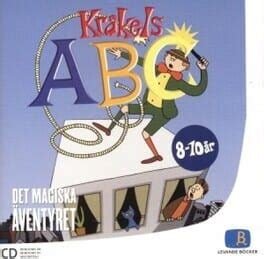- Release Year: 1999
- Platforms: Macintosh, Windows 16-bit, Windows
- Publisher: Levande Böcker i Norden AB
- Developer: ELD Interaktiv Produktion AB
- Genre: Educational
- Perspective: 3rd-person (Other)
- Game Mode: Single-player
- Gameplay: Alphabetizing, Crossword Puzzles, Mechanical Repair, Mini-games, Ordering, Recipe Following, Sorting, Word Games
- Setting: Magical

Description
Krakels ABC: Det magiska äventyret is an educational adventure game for Swedish-speaking children aged eight to ten, featuring the beloved character Krakel Spektakel from the books of author Lennart Hellsing. The game follows a linear magical narrative where the protagonist discovers a magic wand, progressing through fully voiced animated scenes and diverse educational mini-games. These include sorting/ordering tasks, alphabetical word lookup, crossword puzzles, recipe-based cooking, word games, and mechanical repairs, all accessible via point-and-click interface across three difficulty levels.
Gameplay Videos
Krakels ABC: Det magiska äventyret: A Comprehensive Review
Introduction
Krakels ABC: Det magiska äventyret (1999) is a hidden gem in the realm of educational gaming, blending the whimsical charm of Swedish children’s literature with interactive learning. Developed by ELD Interaktiv Produktion AB and published by Levande Böcker i Norden AB, this point-and-click adventure is based on the beloved character Krakel Spektakel, created by author Lennart Hellsing. Designed for children aged 8 to 10, the game seamlessly integrates storytelling, magic, and educational mini-games to foster literacy and problem-solving skills. This review explores its development, narrative depth, gameplay mechanics, and lasting legacy, arguing that Krakels ABC stands as a pioneering example of how educational software can be both engaging and pedagogically sound.
Development History & Context
The Studio & Creative Vision
ELD Interaktiv Produktion AB, a Swedish developer, specialized in educational titles, often collaborating with literary figures like Lennart Hellsing. Krakels ABC was part of a broader series leveraging Hellsing’s characters to teach reading, writing, and logic. The team included 49 contributors, from programmers to pedagogical consultants, ensuring a balance between entertainment and education.
Technological Constraints & Gaming Landscape
Released in 1999, the game was developed for Windows (16-bit and 32-bit) and Macintosh, reflecting the era’s transition to CD-ROM-based gaming. The fixed/flip-screen visuals and point-and-click interface were standard for educational titles of the time, though the fully voiced dialogue and animated cutscenes were notable for their polish. Competitors like Reader Rabbit and The ClueFinders dominated the market, but Krakels ABC distinguished itself through its Swedish cultural context and integration of local literary icons.
Narrative & Thematic Deep Dive
Plot & Characters
The story follows Krakel Spektakel and his friends in the village of Näppelunda, where a wizard’s crash causes magical artifacts to scatter. Players assist Krakel in retrieving these items by solving puzzles tied to reading, spelling, and logic. The linear narrative unfolds through animated scenes, with dialogue recorded by Swedish voice actors, adding authenticity and charm.
Educational Themes
- Literacy Focus: Mini-games like alphabetical sorting, crossword puzzles, and word searches reinforce vocabulary and spelling.
- Problem-Solving: Tasks such as repairing a mechanical device or cooking from a recipe teach sequencing and critical thinking.
- Cultural Relevance: The use of Swedish language and folklore makes it uniquely accessible to native speakers.
Gameplay Mechanics & Systems
Core Loop
The game alternates between story-driven cutscenes and mini-games, each tied to a specific educational objective. The three difficulty levels ensure scalability for different skill levels.
Strengths & Flaws
- Innovative: The blend of narrative and mini-games was ahead of its time for educational software.
- Accessibility: The point-and-click interface is intuitive for young players.
- Limitations: The fixed-screen design feels dated, and the lack of modern replayability features (e.g., save progress) is a drawback.
World-Building, Art & Sound
Visual Design
The art style is cartoonish and colorful, aligning with Lennart Hellsing’s illustrations. Backgrounds are static but detailed, with character animations adding life to the story.
Sound & Music
Fully voiced dialogue enhances immersion, while sound effects (e.g., magical spells) reinforce the fantasy setting. The soundtrack is cheerful and unobtrusive, typical of children’s educational games.
Reception & Legacy
Critical & Commercial Reception
No formal reviews exist, but its inclusion in the Krakels ABC series suggests commercial success. The game’s pedagogical approach aligns with Swedish educational standards, likely contributing to its adoption in schools.
Influence
While not as globally recognized as Reader Rabbit, Krakels ABC exemplifies how local literature can be adapted into effective educational tools. Its legacy lies in its cultural specificity and the series’ enduring popularity in Sweden.
Conclusion
Krakels ABC: Det magiska äventyret is a testament to the power of storytelling in education. Though technologically modest by today’s standards, its creative integration of narrative and learning remains admirable. For Swedish children of the late 1990s, it was a magical gateway to literacy—proving that educational games can be both fun and meaningful. Verdict: A notable, if niche, entry in gaming history, deserving of preservation and study for its cultural and pedagogical contributions.